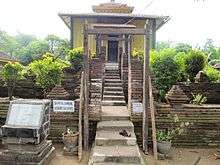Amangkurat I of Mataram

Amangkurat I (Amangkurat Agung) was the sultan of Mataram from 1646 to 1677.
He was the son of the powerful Sultan Agung. Upon taking the throne, he tried to bring long-term stability to the Sultanate of Mataram's realm, which was considerable in area but marred by continual rebellions. He murdered local leaders that were insufficiently deferential to him, including the still-powerful noble from Surabaya, Pangeran Pekik,[1] his father-in-law, and closing ports[2] and destroying ships in coastal cities to prevent them from getting too powerful from their wealth. To further his glory, the new king abandoned Karta, Sultan Agung’s capital, and moved to a grander red-brick palace in Plered (formerly the palace was built of wood).[3]
By the mid-1670s dissatisfaction with the king was turning into open revolt, beginning from the recalcitrant Eastern Java and creeping inward. The crown prince (future Amangkurat II) felt that his life was not safe in the court after he took his father’s concubine with the help of his maternal grandfather, Pangeran Pekik of Surabaya, making Amangkurat I suspicious of a conspiracy among Surabayan factions to grab power in the capital by using Pekiks’ grandson’s powerful position as the crown prince. He conspired with Panembahan Rama from Kajoran, west of Magelang, who proposed a stratagem in which the crown prince financed Rama’s son-in-law, Trunajaya, to begin a rebellion in the East Java.[4] Raden Trunajaya, a prince from Madura, lead a revolt supported by itinerant fighters from faraway Makassar that captured the king's court at Mataram in mid-1677.[5] The king escaped to the north coast with his eldest son, the future king, leaving his younger son Pangeran Puger in Mataram.[6] Apparently more interested in profit and revenge than in running a struggling empire, the rebel Trunajaya looted the court and withdrew to his stronghold in Kediri, East Java, leaving Puger in control of a weak court. Seizing this opportunity, Puger assumed the throne in the ruins of Plered with the title Susuhunan ing Alaga.[7]
Soon after this episode, Amangkurat I died and was succeeded by his eldest son as king in 1677.[8]
See also
References
Footnotes
- ↑ Pigeaud 1976, p. 66.
- ↑ Pigeaud 1976, p. 61.
- ↑ Pigeaud 1976, pp. 54-55.
- ↑ Pigeaud 1976, pp. 67-68.
- ↑ Pigeaud 1976, p. 73.
- ↑ Pigeaud 1976, pp. 74,76.
- ↑ Pigeaud 1976, p. 76.
- ↑ Pigeaud 1976, p. 74.
Bibliography
- Ricklefs, M.C. (2008-09-11). A History of Modern Indonesia Since C.1200. Palgrave Macmillan. ISBN 978-1-137-05201-8.
- Pigeaud, Theodore Gauthier Thomas (1976). Islamic States in Java 1500–1700: Eight Dutch Books and Articles by Dr H. J. de Graaf. The Hague: Martinus Nijhoff. ISBN 90-247-1876-7.
| Regnal titles | ||
|---|---|---|
| Preceded by Sultan Agung |
Sultan of Mataram 1646-1677 |
Succeeded by Amangkurat II |